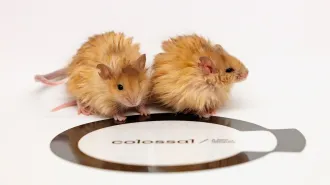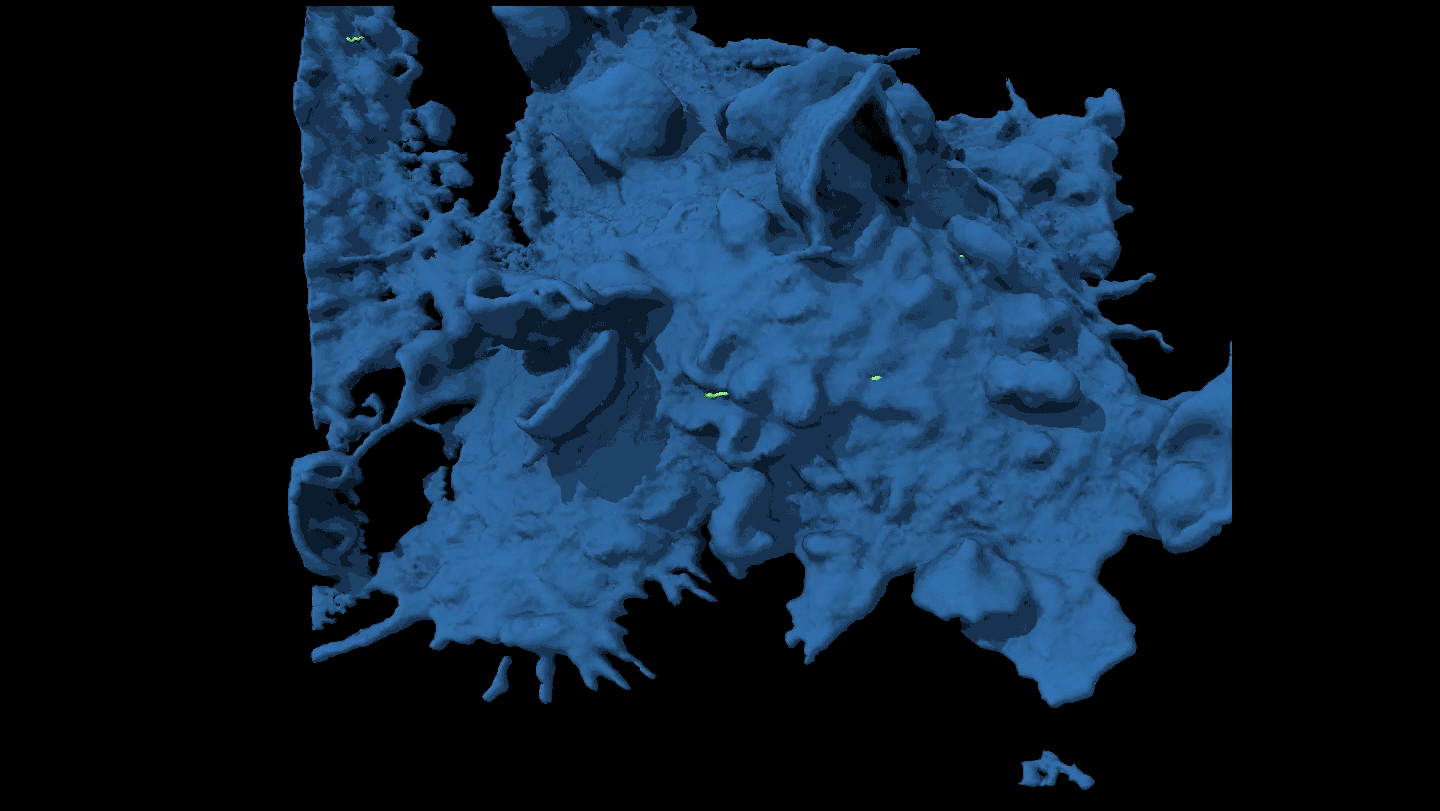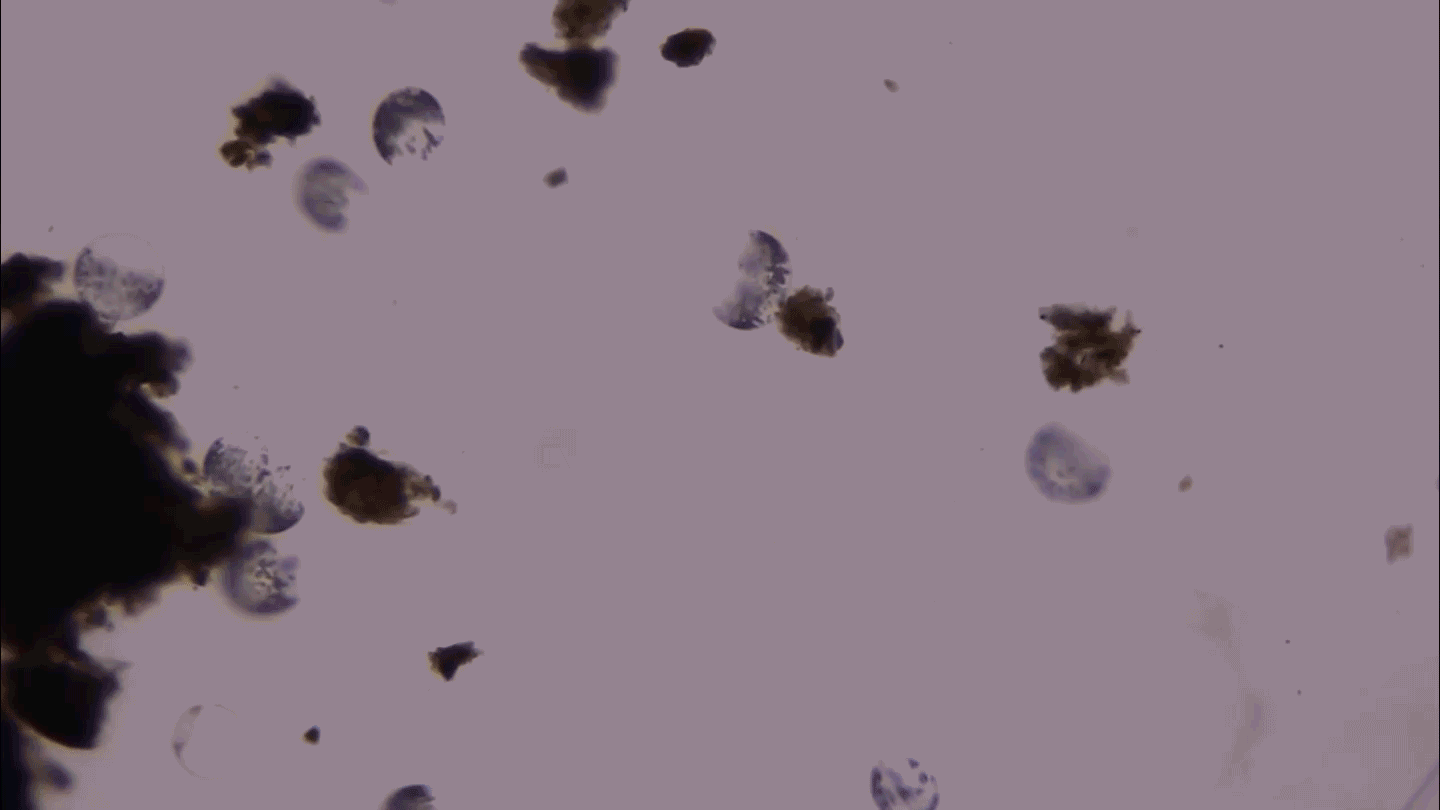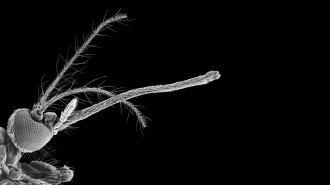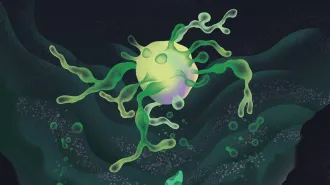Squashing the spotted lanternfly problem may require enlisting other species
Bats, fungi, dogs and even trees could help curb spread of the invasive pest

In the past decade, invasive spotted lanternflies (adult shown in Reading, Pa., in August 2018) have been spreading in the United States.
USDA Photo by Tanya Espinosa
A beautiful menace is on the move in the United States. Polka-dotted, red-and-gray-winged insects are gliding along sidewalks, climbing on plants and crawling up buildings. Spotted youngsters are leaping away to avoid a sticky end at the bottom of a shoe.
Welcome to spotted lanternfly season.
An invasive plant hopper native to parts of China, India and Vietnam, spotted lanternflies (Lycoma delicatula) have been making their way across the Mid-Atlantic and northeastern United States for more than a decade, and some studies suggest they could reach California in the not-too-distant future.
A cache of eggs likely first arrived on a landscaping stone shipment to Berks County in Pennsylvania in 2012, but it wasn’t until 2014 that the insects were first detected. As spotted lanternflies have spread — with established populations in 17 states and counting — they have found plenty of plants to feast on, especially grapevines, sparking worries within the agricultural industry that some crops could be at risk.
“Initially, when they first came into Pennsylvania, we had no idea what was going to happen, says Matthew Helmus, a quantitative ecologist at Temple University in Philadelphia. “They were eating everything and they were feeding on all these different plants.”
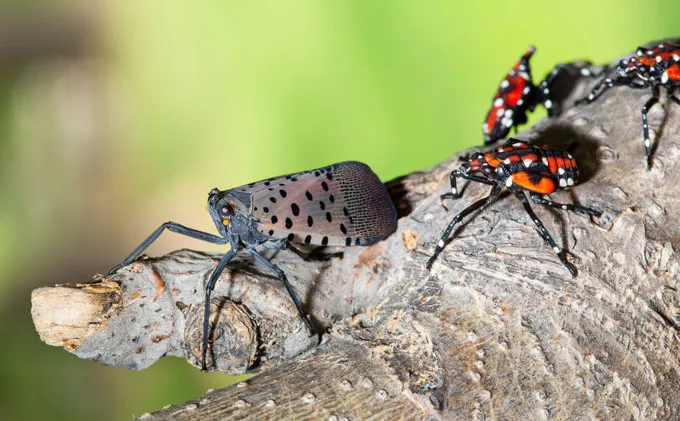
Researchers have since learned that while spotted lanternflies do suck sap from many kinds of plants, few of these plants die. But the critters have a particular affinity for two. One is tree of heaven (Ailanthus altissima), an invasive tree originally from China that arrived in the United States in the late 1700s and is now widespread in many parts of the country. The other is grapevine.
“If you like wine, if you like grape juice, if you like eating grapes, that’s where I think the impact is going to be,” Helmus says. Large infestations can kill grapevines, so grape-growing regions that are still spotted lanternfly-free, including California, Washington and western Pennsylvania, are on high alert for the bugs’ invasion.
Stomping spotted lanternflies on sight has become a popular activity among city-dwellers as the insects roam sidewalks. The plant hoppers are also susceptible to many insecticides. But lanternflies hanging around in unsprayed vegetation surrounding vineyards can move in when the pesticide wears off.
“Nobody wants to put a lot of pesticides out there,” says Flor Acevedo, an entomologist at Penn State. The chemicals are useful for protecting crops but should be applied only where necessary because they can affect more than just the pest bug, she says. They’re “not good for anything. They’re not good for the environment. They’re not good for other organisms. They’re not good for us.”
Probing the spotted lanternfly’s biology and its interactions with other species is revealing other ways to keep its spread in check. As researchers map where spotted lanternflies might pop up next, natural predators and pathogens are among the tools that scientists might harness to curb the spread and damage to vineyards.
Targeting trees of heaven
Tree of heaven and spotted lanternflies are thick as thieves, and controlling one could help control the other.
Spotted lanternfly season officially begins in late spring. That’s when eggs laid in the fall begin to hatch, releasing small, black-spotted nymphs. Over the next months, nymphs feed on sap from more than 70 plant species and grow into teenaged forms called fourth instars as their red stripes appear. Winged adults typically emerge in late July and feed voraciously until fall, when they lay eggs and the first frost of the season kills any surviving adults.

And the adults come on fast. “You’ll see one or two [adults], then all of a sudden you’ll just see them everywhere,” says biologist Erin McHale of Rutgers University in New Brunswick, N.J. “And they’re hitting you in the head as they’re flying by. It’s crazy.”
Where spotted lanternflies were first detected in Pennsylvania, their preferred food source, tree of heaven, was “just everywhere as a weed tree, in between flowers, fields, in the ditches,” says Ann Hajek, an entomologist at Cornell University. With food so readily available, “it was really easy for the spotted lanternflies to increase without people even noticing.”
The pests consume sap from not only tree of heaven and grapevines but also maple, birch and black walnut trees. It’s unclear how feeding on plants not found in their native range in Asia might affect lanternfly reproduction, Acevedo says. Studies show that eating grapevine sap alone, however, probably isn’t the key to spreading widely.
Spotted lanternfly nymphs feeding exclusively on three different kinds of grapes can still make it to adulthood, Acevedo and colleagues reported in the June Environmental Entomology. But fewer survive than those given mixed diets that included tree of heaven sap. Those surviving adults also lay fewer eggs. The findings suggest that culling tree of heaven from the area around vineyards — effectively removing lanternflies’ favorite food source — could help protect crops.

But whether removing tree of heaven will help is up for debate. It’s also possible that the trees might serve as bait, pulling spotted lanternflies away from grapes, Acevedo says. Trees treated with insecticide could be “living traps,” killing nymphs and adults when they cluster on the trees. Experiments removing tree of heaven from infested vineyards could help researchers figure out which method — removal or bait — works better.
It’s also possible that there are other plants growing in the United States that are as good for lanternflies as the tree of heaven, Acevedo says. If such a plant exists, it might serve as a replacement food source. “But so far, based on what we see in the field, lanternflies really, really like tree of heaven.”
Tracking spotted lanternfly spread
Staying one step ahead of spotted lanternflies to protect grape-producing regions is a crucial, albeit astoundingly tough, task.
The bugs haven’t yet invaded major grape regions including California or Washington, Helmus says — though the species “really is sort of knocking on the door of the Lake Erie grape belt” in western Pennsylvania and New York. Without preventative management, spotted lanternflies could become established in California by 2033, researchers reported June 2022 in Communications Biology.
On the move
Spotted lanternflies were first detected in Berks County, Pa., in 2014. Since then, the insects have spread to 16 other states, with most affected counties located in the Northeast. Check to see if your county is on the list.
But such predictions are often less about the specific year and more about where the plant hoppers have a high chance of turning up. That’s because spotted lanternflies aren’t slowly diffusing across the landscape. “It’s these random jumps,” Helmus says. “And those random jumps are all driven by the random things that people do.”
Spotted lanternflies often lay eggs on tree trunks. But their eggs also make their way onto trains, cars and shipping pallets, helping transport the bugs to new places. Some states such as New Jersey have implemented quarantines, meaning businesses need permits to move equipment and goods and people should inspect cars for spotted lanternfly hitchhikers. But egg masses look like gray smears and can be hard to find.
“We can see the adults and nymphs quite well,” says Sally Dickinson, an animal behaviorist at Virginia Tech in Blacksburg. “We can go on a crusade to kill all that we can see … and that’s probably not going to make a dent in the population.” Dogs’ powerful noses, however, can help find eggs hidden in concealed spots.
Trained detection dogs have proven useful for finding spotted lanternfly eggs on farms and at shipping ports, but there aren’t enough dogs to meet the needs for surveillance everywhere. Volunteer dog handler teams can also effectively find eggs, suggesting that people may be able to turn to their own pets to help hunt down spotted lanternflies, Dickinson and colleagues report July 16 in PeerJ.
“This is a proof-of-concept that we don’t have to be employed and doing all of the fancy stuff with all the fancy gear,” Dickinson says. It’s possible that dog and human pairs could one day earn a badge or certification to help hunt down spotted lanternflies or other species.

Tracking where nymphs and adults are making inroads is another way to tell when protective measures are needed. Using paint rollers to collect environmental DNA from trees of heaven or rounding up ants that consume the sap-feeders’ droppings could pick up hints of spotted lanternfly DNA before infestations get large.
One technique uses computers to identify individual insects, which could help find exploding populations. Spotted lanternfly wing patterns are unique, researchers reported February 2023 in Frontiers of Insect Science. Helmus and colleagues have tested such “wingerprinting” in the field, using thousands of photos from around Temple University’s campus to track insects’ movements across trees and estimate how many are hanging around.
Knowing population size could help farms and vineyards figure out treatment options, such as whether to use insecticide and how much. “If there’s only 200 lanternflies out there,” lots of insecticide might not be necessary, Helmus says. “But if there’s 20,000 out there, then that’s a really big deal.”
Finding lanternfly predators and pathogens
Invasive species typically benefit from a lack of predators, but spotted lanternflies may finally be meeting theirs. Some birds have been reported chowing down on spotted lanternflies, as have some predatory arthropods, including spined soldier bugs.
Bats seem to be adopting a new diet as well. Rutgers biologist McHale initially thought that lanternflies were mostly active during the day. But while catching and releasing bats as part of a research project, she and her team would return to campus around three or four in the morning to find the insects climbing up and down building walls.
“That sparked a question in my mind, maybe bats are also eating [lanternflies],” McHale says. “How cool would it be to show that bats are now incorporating these guys into their diet?”
Genetic material extracted from big brown bat and eastern red bat guano in New Jersey showed that the animals are consuming spotted lanternflies, McHale and colleagues reported in Forests in February. The finding suggests that not only might bats help reduce lanternfly populations, but that probing guano for genetic material could also help researchers on the lookout in areas where lanternflies have yet to spread.

In the spotted lanternfly’s native range in China, a fellow insect is on the prowl. There, the parasitoid wasp Anastatus orientalis lays its eggs inside those of spotted lanternflies, preventing them from hatching. The wasp may have helped control spotted lanternfly populations in South Korea after the invasive insect swept through the country in 2004.
Wasps might also help in the United States, though not A. orientalis or A. bifasciatus, a related wasp from Europe. The wasps attack not only spotted lanternfly eggs, but also stink bugs and many other plant hopper relatives native to the United States. Instead, researchers need to find a wasp that kills spotted lanternflies without too many native casualties, says Mari West, an entomologist at the University of California, Riverside and who also works with the U.S. Department of Agriculture
Among the most promising candidates is Dryinus sinicus, another wasp native to China that lays its eggs inside nymphs. The USDA is currently testing whether it has any effect on native plant hoppers, West says. Also under consideration is A. reduvii, a wasp found across North America. A. reduvii attacks lanternfly eggs at high rates, West and colleagues reported in the January Biological Control. “Because it’s already native here, we might expect less of an impact to our native plant hopper or other insect species,” West says.
It’s not just animal predators that have spotted lanternflies in the crosshairs. In October 2018, Cornell entomologist Hajek and colleagues discovered dead adult lanternflies littered on the ground or attached to trees in a wooded area near an apple orchard in Reading, Pa. Two common fungal pathogens — Bakota major and Beauveria bassiana — had caused a mass die-off, the team reported in Proceedings of the National Academy of Sciences in 2019.
The fungi that infected the plant hoppers are found in soils across the United States. And that makes them an attractive bioinsecticide, Hajek says. “It’s not like a synthetic chemical insecticide that can have an unwanted impact on lots more things in the environment and humans.” Many other fungi also infect spotted lanternflies, though it’s unclear whether any might make good bioinsecticides.
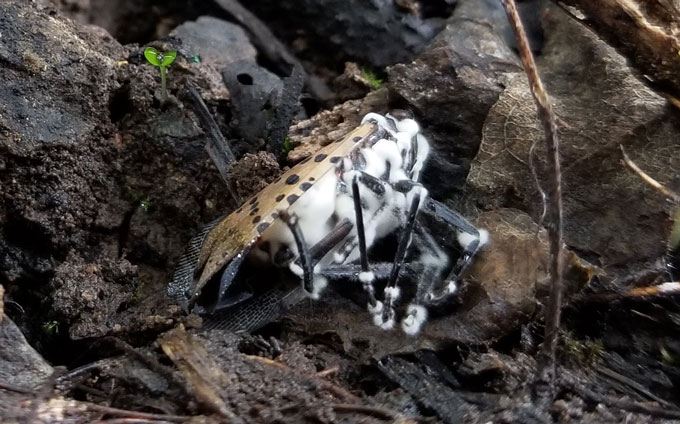
B. bassiana, which coats insect bodies in a white fuzz, is already commercially available to control plant pests, including thrips and aphids. In field tests at a Pennsylvania park, mycoinsecticides using the fungus killed nearly half of fourth instar nymphs and adults after two weeks, Hajek and colleagues reported in 2020 in Environmental Entomology. More than 90 percent of insects died after nine days when the bioinsecticides were applied directly to adults hanging out on potted grapes.
The other fungus, B. major, is not easy to mass produce. But if researchers find a way, it could cause a lot of damage. The fungus sends infected lanternflies climbing up trees or other vertical surfaces, where fungal tendrils anchor its victim to the surface, killing the insect and shooting off spores. B. major “caused a whole lot of infection in the spotted lanternfly population [in the 2018 outbreak] and basically took out the population,” Hajek says. “That’s pretty exciting.”

